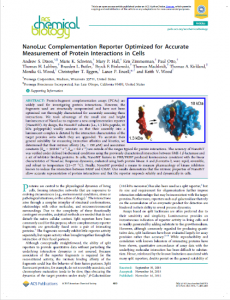
Promega is a chemistry and instrument supplier to scientists in diverse industries and research labs around the world. True. But we are more than just a supply company; we are scientists dedicated to supporting the work of other scientists. We want the science behind the technologies we develop to be both vetted and valued by the scientific community at large, which is one reason our scientists take the time to prepare and submit manuscripts to peer-reviewed journals. Here we call out some of our published research papers that were highly read in 2019. In the journal ACS Chemical Biology alone, five Promega-authored papers were among the top 10 most read papers in 2019. Here’s a quick review of the highlights from these ACS papers.
- Quantitative Live-Cell Kinetic Degradation and Mechanistic Profiling of PROTAC Mode of Action (2018) Riching, K.M. et al. This paper discusses the limitations that have traditionally plagued PROTAC small molecule development. Here the authors describe a modular, live-cell platform to monitor PROTAC-mediated degradation of the bromodomain and extra-terminal protein family members.
- NanoLuc Complementation Reporter Optimized for Accurate Measurement of Protein Interactions in Cells 2015. Dixon, A.S. et al. This paper introduces NanoBiT®, a structural complementation reporter based on NanoLuc® luciferase. NanoLuc® luciferase was separated into two parts: a smaller 11aa peptide (SmBiT) and a larger 156aa subunit (LgBiT), and the two have low affinity for each other. This system is perfect for studying protein:protein interactions. When a target protein tagged with LgBiT interacts with a protein tagged with SmBiT, the two subunits will complement each other and form a bright, luminescent enzyme. Even better, the LgBiT:SmBiT interaction is reversible and can be detected in real time.
- CRISPR-Mediated Tagging of Endogenous Proteins with a Luminescent Peptide 2017 Schwinn, M.K. et al. This 2017 paper introduces: HiBiT, a tiny 11aa protein tag. For scientists studying endogenous protein expression, the HiBiT Tagging System combines quantitative and highly sensitive luminescence-based measurement with a tiny-sized tag that can be easily inserted into endogenous protein via CRISPR/Cas9 gene editing with little impact on native protein function. The HiBiT Tagging System was listed as a 2017 Top 10 Innovation by The Scientist.
- HaloTag: A Novel Protein Labeling Technology for Cell Imaging and Protein Analysis 2008. Los, G.V. et al. This HaloTag® paper was published back in 2008, but it’s still one of the most read papers in 2020! The HaloTag® protein is a 34kDa monomeric derivative of dehalogenase. It was engineered to enhance expression and solubility of recombinant proteins in E. coli and to provide efficient protein purification coupled with tag removal. When expressed as N-terminal HaloTag® fusions in E. coli, target proteins can be produced at higher levels with higher solubility compared to other fusion tags. Using the HaloTag® Protein Purification System, you can get protein of higher yield, purity and free of tag.
- NanoBRET–A Novel BRET Platform for the Analysis of Protein-Protein Interactions. (2015) Machleidt, T. et al. Traditional methods for studying protein:protein interactions are commonly performed in vitro using protein fragments, but they don’t necessarily reflect what happens in a natural cellular environment. The NanoBRET™ PPI system uses NanoLuc® Luciferase as a BRET energy donor and HaloTag® protein as the energy acceptor to measure the interaction of specific protein pairs. The improved spectral overlap, higher sensitivity, increased signal and lower background, provide researchers with a reproducible method for studying protein interactions expressed at physiologically relevant levels.
Related Posts
The following two tabs change content below.


Michele Arduengo
Supervisor, Digital Marketing Program Group at Promega Corporation
Michele earned her B.A. in biology at Wesleyan College in Macon, GA, and her PhD through the BCDB Program at Emory University in Atlanta, GA where she studied cell differentiation in the model system C. elegans. She taught on the faculty of Morningside University in Sioux City, IA, and continues to mentor science writers and teachers through volunteer activities. Michele manages the digital marketing program team at Promega.
Latest posts by Michele Arduengo (see all)
- An Unexpected Role for RNA Methylation in Mitosis Leads to New Understanding of Neurodevelopmental Disorders - March 27, 2025
- Unlocking the Secrets of ADP-Ribosylation with Arg-C Ultra Protease, a Key Enzyme for Studying Ester-Linked Protein Modifications - November 13, 2024
- Exploring the Respiratory Virus Landscape: Pre-Pandemic Data and Pandemic Preparedness - October 29, 2024
